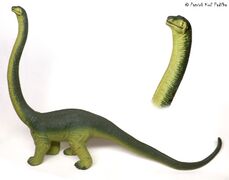Diplodocus
Jump to navigation
Jump to search
| phylum | Chordata | Diplodocus lived in what is now western North America at the end of the Jurassic Period. It is one of the more common dinosaur fossils found in the Upper Morrison Formation, a sequence of shallow marine and alluvial sediments deposited about 155 to 148 million years ago. Diplodocus is among the most easily identifiable dinosaurs, with its classic dinosaur shape, long neck and tail and four sturdy legs. For many years, it was the longest dinosaur known. Its great size may have been a deterrent to the predators Allosaurus and Ceratosaurus: their remains have been found in the same strata, which suggests they coexisted with Diplodocus.
For more information, visit the Wikipedia entry. Get back to Sauropodomorpha |
| clade | Diapsida | |
| clade | Saurischia | |
| clade | Sauropoda | |
| family | Diplodocidae | |
| genus | Diplodocus | |
| Temporal range | Late Jurassic |
Diplodocus hallorum
| phylum | Chordata | First described in 1991 by Gillette as Seismosaurus halli from a partial skeleton comprising vertebrae, pelvis and ribs. George Olshevsky later attempted to emend the name as S. hallorum, citing incorrect grammar on the part of the original authors, a recommendation that has been followed by others, including Carpenter (2006). In 2004, a presentation at the annual conference of the Geological Society of America made a case for Seismosaurus being a junior synonym of Diplodocus. This was followed by a much more detailed publication in 2006, which not only renamed the species Diplodocus hallorum, but also speculated that it could prove to be the same as D. longus.
For more information, visit the Wikipedia entry. Get back to Sauropoda |
| clade | Diapsida | |
| order | Saurischia | |
| Infraorder | Sauropoda | |
| family | Diplodocidae | |
| genus | Diplodocus | |
| species | D. hallorum | |
| Period | Late Jurassic |
Diplodocus Skeleton
Go to Diplodocus main page




























